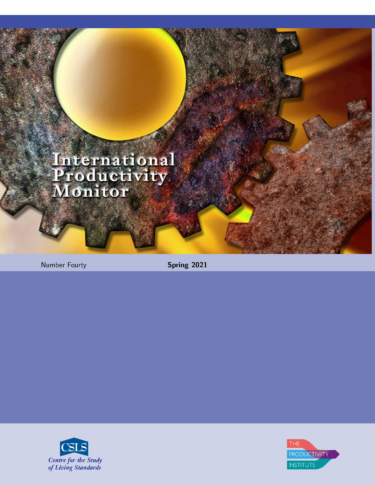Number 40, Spring 2021
The International Productivity Monitor (IPM) is the joint flagship publication of the Centre for the Study of Living Standards (CSLS) in Canada and The Productivity Institute.
Articles from the current edition of the IPM can be accessed below. Access to back issues from before 2021 as well as information on submission of papers for publication in the IPM can be obtained from the CSLS website.
To receive publication information and updates from the International Productivity Monitor, please subscribe to our mailing list.
The International Productivity Monitor is a completely Open Access journal published by the Centre for the Study of Living Standards (CSLS). The objective of the Monitor is to focus attention on the importance of productivity for improving living standards and quality of life. The Monitor ranks within the top fifth of all economic journals on RePEc with an impact factor of 2.718, and is in the top 10 per cent of all economic journals by file downloads.
The Monitor publishes high-quality peer-reviewed articles on productivity issues, trends and developments in Canada, the United Kingdom and other countries and serves as a vehicle for the international discussion of productivity topics. We do not charge submission fees for these articles. Print and online versions are published twice a year in English. The articles are largely nontechnical in nature and understandable to a wide audience of productivity researchers and analysts as well as the general public. The publication is distributed electronically to anyone interested in productivity issues on a complimentary basis.

Number 40, Spring 2021
- Editor’s Overview Andrew Sharpe and Bart van Ark
- Masthead
- Full text
- Inside Back Cover With CSLA And TPI acknowledgements
Pay and Productivity in Canada: Growing Together, Only Slower than Ever David M. Williams
- Pay and labour productivity growth in Canada are broadly aligned over the long run since 1961 and during the 2008-19 business cycle. The slowdown in Canada’s productivity growth rate since 2000, the general stability of the labour share, and the lack of further gains in labour’s terms of trade after 2008 largely explain the slowdown in workers’ real pay growth over the 2008-19 business cycle. Canadians should be concerned about the country’s persistently low productivity growth because it leads to low real pay growth. Canada’s policymaking institutions should prioritize understanding and accelerating productivity.
Benchmarking the Productivity Performance of New Zealand’s Frontier Firms Guanyu Zheng, Hoang Minh Duy and Gail Pacheco
- This study compares the relative performance of New Zealand’s firms to several small advanced economies using novel cross-country microdata from CompNet. We present stylised facts for New Zealand relative to Belgium, Denmark, Finland, Netherlands and Sweden based on average productivity levels, as well as benchmarking laggard, median and frontier firms. This research also employs an analytical framework of technology diffusion to evaluate the extent of productivity convergence, and the impact of the productivity frontier on non-frontier firm performance. Results show that New Zealand’s firms have comparatively low productivity levels and that its frontier firms are not benefiting from the diffusion of best technologies outside the nation. Furthermore, there is evidence of labour misallocation in New Zealand based on less labour-productive firms having disproportionally larger employment shares than their more productive counterparts.
The Causes of Japan’s Economic Slowdown: An Analysis Based on the Japan Industrial Productivity Database Kyoji Fukao, YoungGak Kim and HyeogUg Kwon
- Using the Japan Industrial Productivity Database (JIP) and the EU KLEMS database 2017, we compare the sources of economic growth of Japan, the United States, Germany, France, and the U.K. for the period 1995–2015 using growth accounting. We find that the reasons why Japan’s economic growth during the 2005–2015 period was much lower than that of the other major economies are the decline in the working-age population and sluggish investment in capital services. Among the five countries, Japan was the only one whose growth rate of the capital stock was lower than the steady state growth rate. Another reason for the slowdown in Japan’s economic growth in 2005–2015 was the decline in TFP growth, which was caused by a drop in productivity growth in a small number of industries, including electronic data processing machines, electricity, and wholesale trade.
Measuring the Volume of Services Industries Output and Productivity: An Audit of Services Producer Price Indices in OECD Countries Mary O’Mahony and Lea Samek
- This article discusses measurement of Services Producer Price Indices, which are important in estimating the volume of the output of services sectors. Price indices for 31 individual services activities were downloaded from the websites of National Statistical Offices for 16 OECD countries and compared to those for the UK. The results show that UK services prices tend on average to have either lower or equal price growth than in other countries, suggesting that an underestimate of services output growth is not likely to be a greater problem in the UK than in other comparable countries. Nevertheless, there may be common biases across countries due to inadequate adjustments for quality. Further analysis of measurement methods suggests a small but significant positive bias in price inflation for one commonly employed method based on time spent on the provision of services. This means that the growth in the volume of services activity may be understated in general in the group of countries considered in this article.
ViewPoint: Canada Should Establish An Equitable Growth Institute Don Drummond
- Canada faces serious economic challenges and needs strategic policy advice to succeed. Productivity growth must rise from the mediocre trend of recent decades. The spoils of growth should be more evenly distributed. As a carbon-intensive economy, the adjustment to net zero emissions will require fundamental change. The Government of Canada has benefited from advice from occasional advisory groups, but it has been decades since there has been a comprehensive, multi-year policy research effort. The time has come to establish an Equitable Growth Institute. It should align with the objectives of the Government but have sufficient independence to tackle tough issues. Provinces and territories must be involved as they hold many of the policy levers. In addition to having its own governance structure and researchers, it should bring together and where appropriate create networks of researchers. The Institute should delve into big questions of the day, including whether and how a Quality of Life framework can inform decision-making and whether there are tradeoffs or complementarity between economic growth and equity and sustainability objectives.
Putting Together the Pieces of the Productivity Puzzle: Review Article of Productivity Perspectives and Productivity and the Pandemic Bart van Ark
- The productivity puzzle in the UK may have taken a turn with the arrival of the COVID-19 crisis although we do not know at this point whether it will be for the better or the worse. The two edited volumes discussed in this review article are distinguished by the first being produced just before the pandemic, and the second in the midst of it. Together, the volumes address a broad range of economic, social and policy issues related to the productivity puzzle in the UK, with a strong focus on organization, management, entrepreneurship, innovation and skills. Beyond the firm there is much emphasis on inequality between firms, people and especially regions. There is also a strong plea for a system-based approach to policy making for productivity. On the whole the contributors take a cautious approach on how much the pandemic will change productivity performance in the medium-term, but they argue strongly in favour of active policy intervention to prevent damage and create better conditions for a sustained productivity revival.
- Bert Balk from Erasmus University discusses the volume Measurement of Productivity and Efficiency: Theory and Practice. Balk comments that productivity researchers in the neoclassical school, who assume firms act efficiently could learn from researchers in the data envelopment and stochastic frontier analysis field where the focus is on efficiency and the many ways to measure it.






